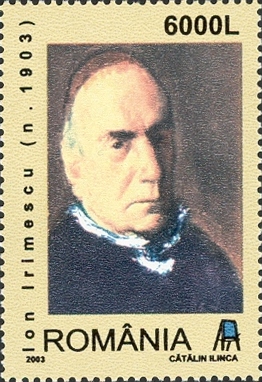Ion Irimescu facts for kids
Quick facts for kids
Ion Irimescu
|
|
|---|---|

Ion Irimescu on a Romanian stamp from 2003
|
|
| Born | 27 February 1903 |
| Died | 28 October 2005 (aged 102) |
| Nationality | Romanian |
| Education | Dimitrie Paciurea, Joseph Bernard |
| Known for | Sculpting, Sketching |
|
Notable work
|
George Enescu - portrait |
| Movement | Modernism |
Ion Irimescu was a super talented Romanian artist. He was born on February 27, 1903, and lived a very long life until October 28, 2005. He was famous for his amazing sculptures and drawings. People often called him the "patriarch" or wise elder of Romanian art. In 2001, he even won a special award for his contributions to Romanian culture.
Contents
Early Life and Education
Ion Irimescu was born in a town called Fălticeni, in Romania. His parents were Petre and Maria Irimescu. He also had two brothers, Alexandru and Verona. After finishing primary school in 1915, he went to Nicu Gane High School in his hometown. While there, he showed his artistic side by helping with theater decorations.
From 1924 to 1928, Ion studied at the Bucharest National University of Arts. Here, he learned from famous teachers like Dimitrie Paciurea and Oscar Han. Even as a student, he was busy creating art. He painted the Saints Archangels Michael and Gabriel Church in Oprișeni, Fălticeni. After graduating, he became an art teacher in Fălticeni. In 1933, he married Eugenia Augustina Melidon, who was also a teacher. He continued teaching art in different schools, sharing his passion with young people.
Artistic Journey and Exhibitions
Ion Irimescu started his career with a bang! In 1928, right after finishing art school, he showed his work "Eden" at a big exhibition in Bucharest. The next year, he displayed more of his art at important shows in Romania and France.
Studying in Paris
In 1930, Ion received a special scholarship. This allowed him to travel to Paris, France, which was a major art center. He studied at the Académie de la Grande Chaumière. There, he learned from the famous teacher Joseph Bernard. He was also greatly inspired by the sculptures of Antoine Bourdelle. In 1932, his self-portrait won an honorable mention at a Paris art show. He also showed his "Portrait of a Girl" at another important exhibition.
Return to Romania and Global Recognition
Ion Irimescu came back to Romania in 1933. From then on, he participated in many art exhibitions both in Romania and around the world. In 1940, he became a teacher at the Belle Arte Academy in Iași. Later, he taught in Cluj and then in Bucharest, at the Nicolae Grigorescu Plastic Arts Institute.
His art was shown in many countries. He exhibited his sculptures in places like Venice, Paris, London, Rome, Berlin, and even Tel Aviv. In 1971, he received a high honor, the Order of the Star of the Romanian Socialist Republic.
The "Ion Irimescu" Collection
In 1975, Ion Irimescu did something amazing for his hometown. He gave a huge collection of his sculptures and drawings to the Fălticeni Museum. This gift helped create the "Ion Irimescu" Collection. It became the largest permanent collection of works by a single artist in Romania! He donated about 300 sculptures and 1,000 drawings.
From 1978 to 1989, he was the president of the Romanian Plastic Artists' Union. This meant he led the group for artists in Romania.
Famous Works and Legacy
One of Ion Irimescu's famous sculptures is a statue of Dimitrie Cantemir. This statue was placed in the Biblioteca Ambrosiana in Milan, Italy. It stood proudly between statues of other famous writers, Dante and Shakespeare.
Ion Irimescu had an interesting story about one of his works. He once met with Nicolae Ceaușescu, who was the leader of Romania at the time. Irimescu wanted to sculpt a large bronze statue of the writer Mihail Sadoveanu. However, he didn't have enough material. To his surprise, Ceaușescu sent him a statue of Joseph Stalin as a gift. Irimescu then cleverly reshaped the Stalin statue into the statue of Sadoveanu.
On his 100th birthday in 2003, the Romanian Academy celebrated his long and successful life. Towards the end of his life, he returned to Fălticeni. He spent his time looking after the museum that held so many of his precious artworks.
Ion Irimescu passed away on October 28, 2005, at the age of 102. He was buried in the Oprișeni Cemetery. His incredible art and generous donations continue to inspire people today.

